When the envoy of King Charles II of England saw Polish hussars for the first time, he was amazed. He wrote in the diary:This army is the finest thing that has been seen. And it was not an isolated opinion. Does this mean that there was no way to deal with the hussars? As it turns out, a few would be found.
Method one - use the terrain
In all the history of mankind there has never been a military that has won always and under all circumstances . Each formation had its strengths and weaknesses. Therefore, armies usually consisted of various types of troops that complemented each other. This allowed them to fight more effectively.
The limitations of individual formations have been known “since forever”. They were also realized in the era of hussars (16th-18th century). For example, in the 16th century, Marcin Bielski noted:
(...) if you have people on foot against a driving enemy, [u] put [them] in uneven places, such as mud, valleys, rough; if you have riding people against pedestrians, put them in an even field, they may be [and if possible, then] in a place a little higher [towering above the surroundings], where nothing, neither mud nor water, would pass [interfered] .
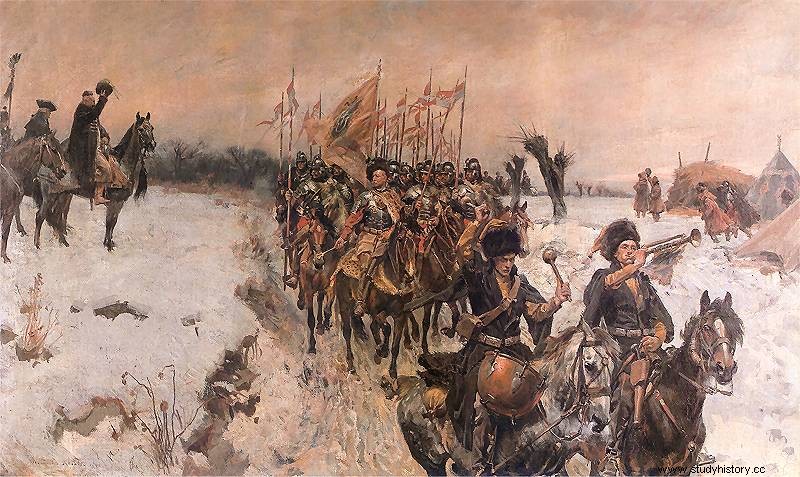
The effectiveness of the hussars largely depended on the favorable field conditions. The illustration shows Wojciech Kossak's painting "The Hussar's Banner" (source:public domain).
For the result of the clash, the terrain was one of the most important factors. What did it mean for hussars?
Imagine, the Reader, that you are a hussar, in front of whom, a few hundred meters away, infantry developed their lines . What are you doing? You charge and you win? You can try, but if a deep and wide ditch stands in your way, despite your best efforts, you will not be able to defeat the enemy.
Hussars were sometimes in such a situation. For example, in the battle with the Swedish army at Kłecko in 1656. As one of the riders fighting there noted:
He ordered [Robert Douglas] his troops to take a convenient position over a deep drainage ditch, and began to hit us with bullets, himself protected from the thrusts of our copies, as he ditched it he separated us from.
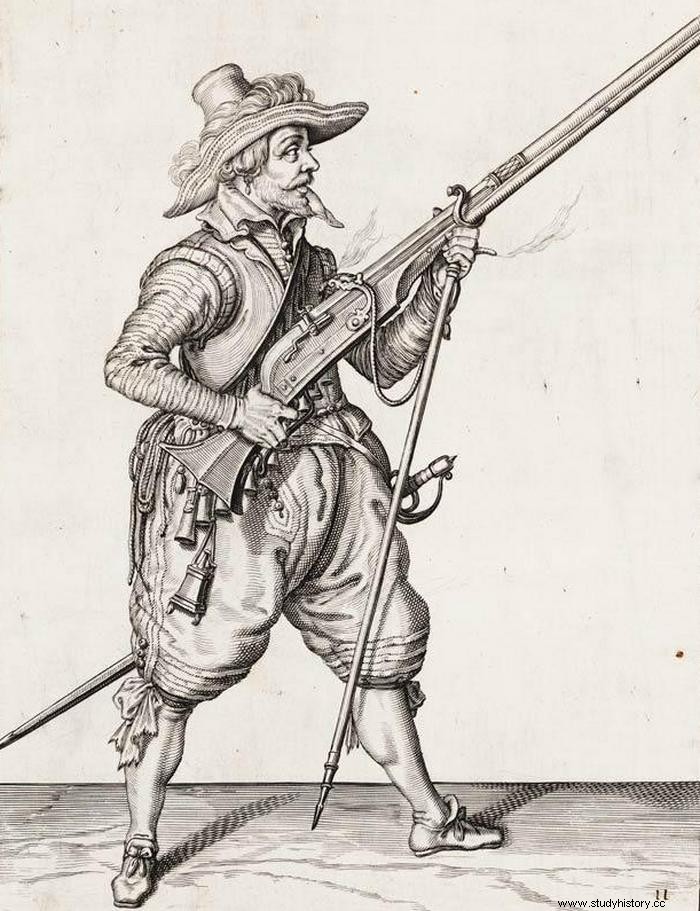
The firearms were not able to do much damage to the hussars (source:public domain).
It was similar at Gniew on September 29, 1626, where frequent free [passage] ditches in the Olęder field and straight running towards the enemy did not allow and where Mr [Tomasz Zamojski] had to be from the ditches, which were difficult to stay, and from those traps to seduce his riders into the croup .
In such situations, the enormous resistance of Poles to the fire of firearms, the effectiveness of which, contrary to what historians previously reported, was in fact insignificant, was of no avail. It wasn't musket or cannon fire, but ditches that kept the hussars back .
And not only them. There were many more different kinds of terrain obstacles. Hussars were of no use in swamps or in dense woods. Nothing on the winding, narrow mountain paths. Its usability was very limited in wetlands or overgrown with brushwood.
Method two - keep mobile obstacles at hand
Topography was not the only concern of the hussars. For thousands of years, man has perfected the natural defensive properties of the area. Hence, all kinds of palisades, cobblestones, embankments, entrenchments, moats, redoubts, wolf pits and a whole lot of other "inventions". But that's not all.
Mobile obstacles were used to protect moving people. In the era of the hussars, in our part of Europe, the use of carts was popular riding in a row, manned by armed men. Breaking down such a "mobile fortress" was quite a challenge. When the rolling stock stopped, the horses were unhitched, the wagons chained and dug around the ditch.
Even in the 17th century, the Muscovites were eager to use a different kind of obstacle - scooters . They were plank walls with loopholes. Due to the fact that they were placed on wheels or sleds, they also protected people during the march.
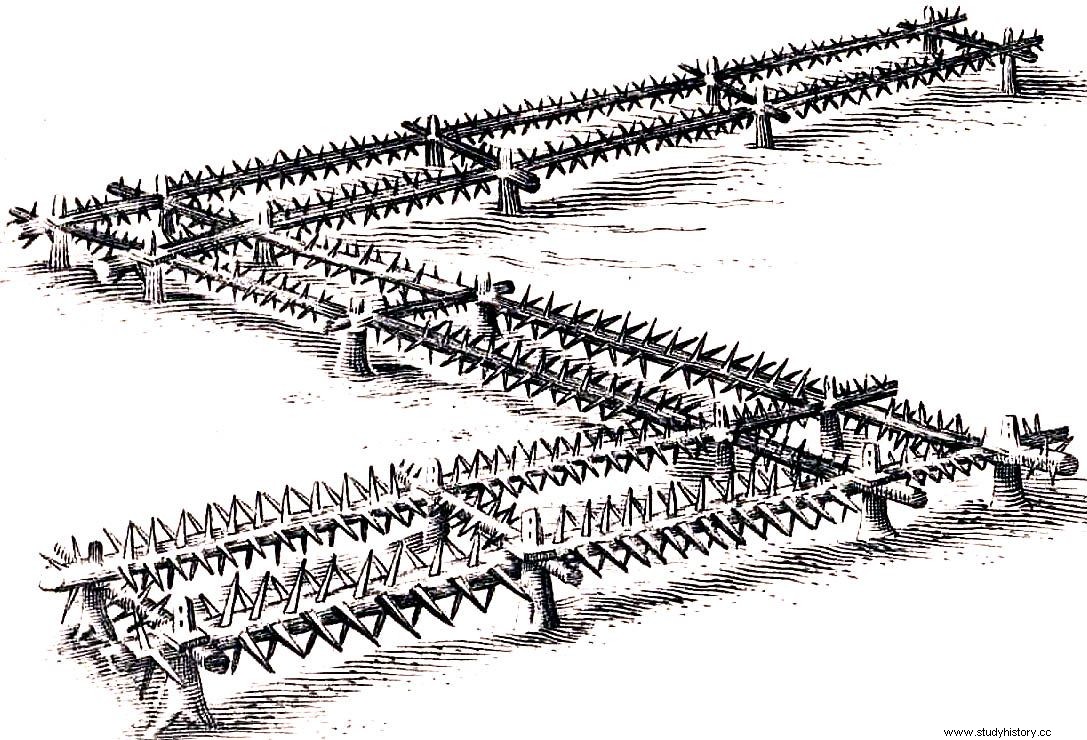
One of the ways to stop the hussars could be mare. Drawing from the collection of Radosław Sikora.
In Western Europe, something else was invented. The so-called Spanish goats (alternatively known in Poland as "Spanish riders", "spansrajtars", "spansrejterami", "tollers", "ostrostawounds", "spurs", and at the beginning of the 18th century also "czośnicy") had a number of advantages. They were as effective against cavalry as stationary mare, but thanks to their design and low weight, they could be moved around the battlefield .
Another advantage was that they did not get flaky like you could with "pig feathers", which is a series of short pikes stuck into the ground.
Spanish goats were used by the Swedes in the Battle of Kliszów in 1702 (also known as the Battle of Kiev). They stopped the charge of Polish hussars and tankers. It is worth emphasizing the role of these obstacles in the fall of the hussars.

The Battle of Kliszów in the 18th-century painting by an unknown author (source:public domain).
It was not the fire of a modernized firearm, as some would believe, but the Spanish goats that allowed the infantry to successfully face the hussars . It was for this reason that the draft reform of the Polish army, submitted in 1710, stated:
As hussars used to be terrible before, now they have a way for them to put infantry in front of them [Spanish goats], through which it is difficult to make a copy, as an example he was after Kijami [Kliszowem]
Third method - use a smart maneuver
Artificial or natural obstacles did not exhaust the arsenal of measures that could be used against the hussars. In addition to separating oneself from them maneuvers were practiced that eliminated the overwhelming advantage of the front-charging spearmen .
One of them (used by the Turks, Tatars, Muscovites and Swedes) was to part in front of the Hussars and then strike their wings and rear. This was done, for example, on the second day of the Battle of Warsaw in 1656, where the Swedish king Charles X Gustav:
commanded all his brigade and regiment commanders to step aside [their troops] when hussars or spearmen attack them and let their [hussars] as he knew, he could not be held by any force or tactic then.
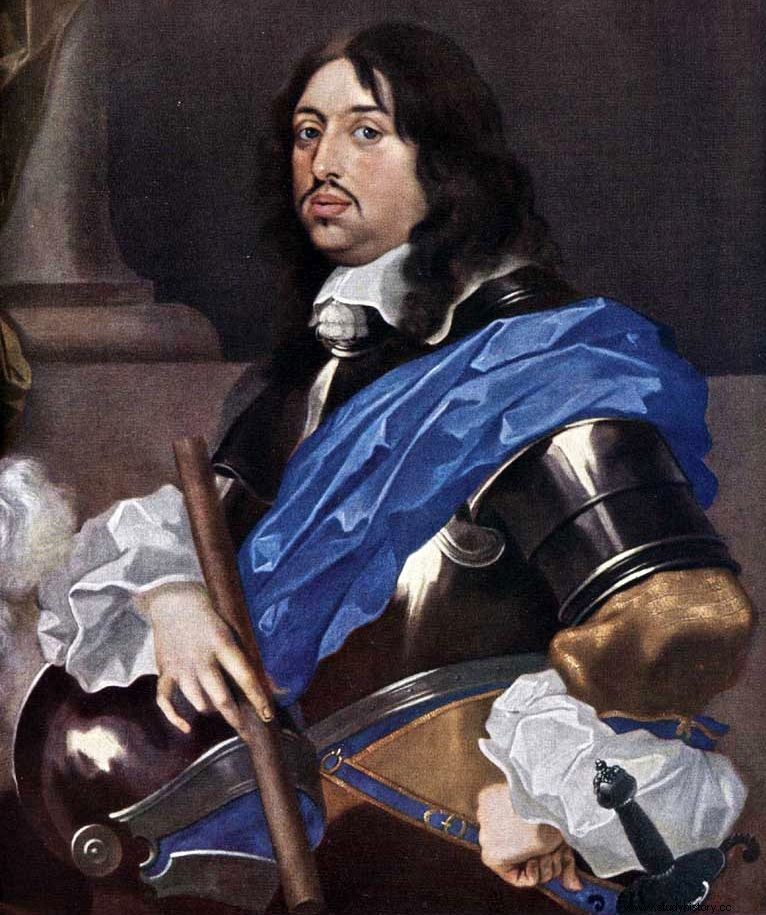
The tactic used by Charles X Gustav during the Battle of Warsaw successfully neutralized the threat posed by the hussars (source:public domain).
The Swedes obeyed the orders, thanks to which the famous charge of Lithuanian hussars under Aleksander Hilary Połubiński was repulsed. The knights, who were initially parted, ran into the "sack". Surrounded on all sides by the many times larger enemy, after a hard fight and considerable losses, they broke out of the trap and returned to their starting positions.
Fourth method - attack by surprise
The Tatars also knew this way of fighting, but whenever they could, they chose a different option. The military did not maintain full combat readiness . There were times when this readiness decreased drastically . For example, when they were dissolved on a winter lair. It was then that the unexpected intrusion into the Polish-Lithuanian Commonwealth and the attack on dispersed troops brought spectacular results.
One of such events was noted by the courtier of Jan III Sobieski, Frenchman Françoise Paulin Dalerac:
In 1688. the Tatars made an excursion to Volhynia; where some of the Infantry Regiments scattered, who stood in the city, girded Palisades. They also took a few banners of the whole Hussars, as the Gazeta [Gazette de France] wrote:But they were not there for that time, only the Poczta Polska; besides, there was no Banner complete; because, the Banner of Great Chancellor Littewski, which was then taken, did not have with her, only seven, that is, eight Post Offices, left to guard the Banner.
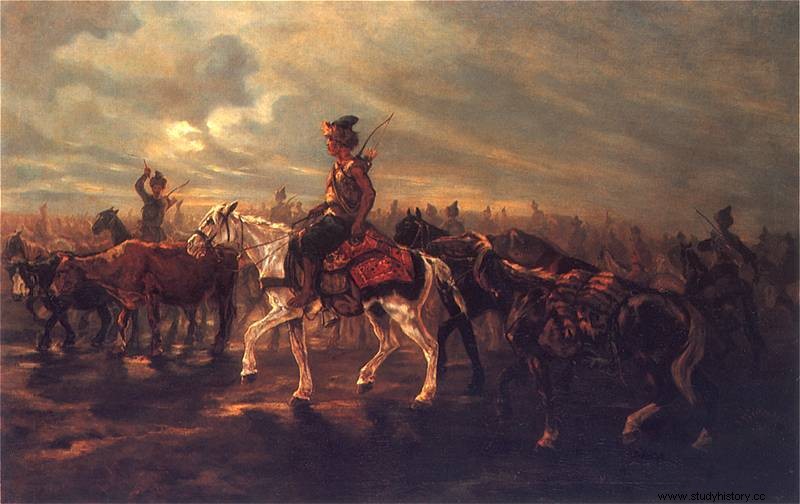
The Tatars also had proven ways to fight the hussars. The illustration shows a painting by Józef Brandt showing the Tatar procession (source:public domain).
Surprise has always been a welcome thing. They were obtained in various ways. It was possible to simulate an escape, and after loosening the pursuers' ranks, turn around and hit them with full force. It was also possible to hit the enemy crossing the river. Thanks to the speed and endurance of their horses, the Tatars liked precisely such methods of fighting, although of course not only they knew and used them.
The fifth way - buy a lot, gentlemen!
When everything else failed, the last resort was the most primitive means, that is to bring a much larger army into battle .
This method was not always effective, as evidenced by the series of victorious hussars' charges. However, sometimes the numerical superiority and sacrifice of the first throws allowed to slow down the impetus of the charging spearmen and loosen their ranks, thanks to which the soldiers standing deeper, rested and ready for battle could start a fight with the hussars. And even, as the episode from the first day of the battle of Tczew in 1627 showed, to win the battle.
Studies:
- Kuba Pokojski, Tczew 1627 . Warsaw 2015.
